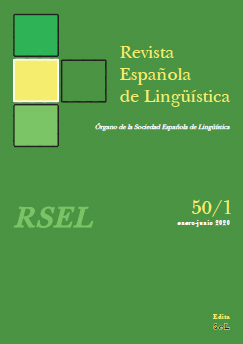El masculino inclusivo en español
doi: http://dx.doi.org/10.31810/RSEL.50.1.2
Palabras clave:
Sexo; género; identidad de género; morfología; gramática del español., Sex; Gender; Gender Identity; Morphology; Spanish grammar.Resumen
El presente estudio considera críticamente propuestas recientes que cuestionan tanto el uso como la propia existencia del llamado masculino genérico en español. Se desarrolla un modelo de la estructura gramatical del género en español según la cual los nombres de persona masculinos (salvo ciertas excepciones) no incluyen información semántica relativa al sexo y son, por tanto, epicenos con género por defecto. Se argumenta que el uso de este masculino inclusivo no es el causante de la invisibilización de las mujeres en el discurso y que su evitación es innecesaria, además de gramaticalmente inconsistente.
Descargas
Citas
Ackerman, L. (2019): «Syntactic and cognitive issues in investigating gendered coreference», Glossa: A Journal of General Linguistics 4, 1, p. 117.
Aliaga Jiménez, J. L. (2018): Lenguaje inclusivo con perspectiva de género, Zaragoza, Gobierno de Aragón [en línea]<https://www.aragon.es/documents/20127/186069/Lenguaje+inclusivo+con+perspectiva+de+género/ca98fdb6-0d4c-563a-7f54-2ef933d5a60d?t=1549448641684>.
Ambadiang, T. (1999): «La flexión nominal. Género y número», en Bosque, I. y Demonte, V. (coords.), Gramática descriptiva de la lengua española, Vol. III, Madrid, Espasa, pp. 4843-4913.
Bengoechea, M. (2015): Lengua y género, Madrid, Síntesis.
Booij, G. (2000): «Inflection and derivation», en Booij, G. y otros (eds.), Morphologie/Morphology, Vol. I, Berlín y Nueva York, Walter de Gruyter, pp. 360-369.
Bosque, I. (2012): «Sexismo lingüístico y visibilidad de la mujer», Boletín de Información Lingüística de la Real Academia Española 1, .
Corbett, G. G. (1991): Gender, Cambridge, Cambridge University Press.
–, (2006): Agreement, Cambridge, Cambridge University Press.
Coseriu, E. (1966): El sistema verbal románico, Madrid, Siglo XXI.
Dryer, M. S. y Haspelmath, M. (eds.) (2013): The world atlas of language structures, Leipzig, Max Planck Institute for Evolutionary Anthropology.
Escandell-Vidal, M. V. (2018): «Reflexiones sobre el género como categoría gramatical. Cambio ecológico y tipología lingüística», en Ninova, M. (ed.), De la lingüística a la semiótica: trayectorias y horizontes del estudio de la comunicación, Sofía, Universidad S. Clemente de Ojrid.
Harris, J. S. (1991): «The exponence of gender in Spanish», Linguistic Inquiry 22, pp. 27-62.
Hockett, Charles F. (1958): A course in modern linguistics, Nueva York, Macmillan.
ISLI = Asociación Andaluza de la Lengua: Informe sobre el lenguaje inclusivo [en línea] <https://andaluzadelalengua.files.wordpress.com/2019/04/aalengua_critica_sexismolinguistico.pdf>.
Leonetti, M. (1990): El artículo y la referencia, Madrid, Taurus.
Lliteras, M. (2014): «Los nombres ortónimos en tiempos de la fundación de la Real Academia Española» en Calero, M. L. y otros (eds.), Métodos y resultados actuales en historiografía de la lingüística, Münster, Nodus, pp. 434-444.
NGLE = Real Academia Española y Asociación de Academias de la Lengua Española (2009): Nueva gramática de la lengua española, Madrid, Espasa.
Real Academia Española (1976): Esbozo de una nueva gramática de la lengua española, Madrid, Espasa.
Roca, I. M. (2005): «La gramática y la biología en el género del español», Revista Española de Lingüística 35, pp. 17-44 y 397-492.
Serrano-Dolader, D. (2010): «El género en los sustantivos: ¿flexión y/o derivación?» en Val, J. F. y Horno, M. C. (eds.), La gramática del sentido: léxico y sintaxis en la encrucijada, Zaragoza, Prensas Universitarias, pp. 249-270.
Publicado
Cómo citar
Número
Sección
Derechos de autor 2020 Revista Española de Lingüística

Esta obra está bajo una licencia internacional Creative Commons Atribución-NoComercial 4.0.











